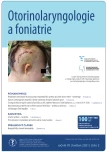Surgical treatment of benign parotid gland tumors in the years 2014–2018 at the ENT department of Hospital České Budějovice, a.s.
Authors:
Zapletalová H. 1; Kuchař M. 2; L. Mrzena 1
Authors‘ workplace:
Otorinolaryngologické oddělení, Nemocnice České Budějovice, a. s.
1; Klinika otorinolaryngologie a chirurgie hlavy a krku 1. LF UK a FN v Motole, Praha
2
Published in:
Otorinolaryngol Foniatr, 70, 2021, No. 2, pp. 82-88.
Category:
Original Article
doi:
https://doi.org/10.48095/ccorl202182
Overview
Introduction: Salivary tumors represent a heterogeneous group of tumors of diverse location, histological structure and bio logical behavior. The purpose of this study was a retrospective evaluation of surgical treatment of a group of patients with newly dia gnosed benign tumors of the parotid salivary gland operated in the years 2014–2018 at the ENT department of Hospital České Budějovice, a.s. Material and methods: A type of surgery, defi nitive histology, postoperative complications and a number of recurrences were monitored. The data were evaluated by descriptive statistical methods. Results: A total of 190 surgeries with benign histological fi ndings in 182 patients were performed. The most common benign result was Warthin‘s tumor (90 cases, 47.4%), followed by pleomorphic adenoma (66 cases, 34.7%). Uncommon histological types of tumors were dia gnosed in 14 patients (7.4%). Non-tumorous fi ndings were found in 20 cases (10.5%). The most frequently performed procedure in 84 cases (44.2%) was extracapsular extirpation. Transient lesion in the area of innervation of the temporofacial and / or cervicofacial branch of the facial nerve was present in 34 (17.9%) patients. Permanent paresis of some of the branches of the facial nerve was reported in 2 (1.1%) patients. In 12 patients, the postoperative course was complicated by the development of salivary fi stula (6.3%). Pleomorphic adenoma relapsed after extracapsular extirpation in 5 cases (20.0%). After partial parotidectomy, one recurrence of pleomorphic adenoma (3.6%) was recorded. Warthin‘s tumor relapsed after simple extirpation in 4 cases (20.0%). Conclusion: Our evaluation results of the surgical treatment of benign parotid gland tumors lead us to make further eff orts improve the care of our patients. We see reserves mainly in the routine use of ultrasonographic examination with performance FNAC and thus planning a safe and suffi ciently radical operational solution.
Keywords:
parotid gland – pleomorphic adenoma – Warthin‘s tumor – parotidectomy – recurrence – facial nerve paresis – FNAC
Sources
1. Klozar J. Speciální otrinolaryngologie. 1. vyd. Praha: Galén a Karolium 2005.
2. Stárek I, Černý L, Simpson Roderick WH et al. Choroby slinných žláz. Praha: Grada 2000.
3. Šlampa P, Smilek P. Nádory hlavy a krku. Praha: Mladá fronta 2016.
4. Lukáš J. Nádory slinných žláz. Postrgraduální medicína 2002; 4(9): 1012–1015.
5. Myers EN, Ferris RL. Salivary Gland Disorders. Berlin Heidelberg: Springer 2007.
6. Chulam TC, Noronha Francisco AL, Goncalves Filho J et al. Warthin‘s tumour of the parotid gland: our experience. Acta Otorhinolaryngol Ital 2013; 33(6): 393–397.
7. Pazdera J, Zbořil V. Papilární cystadenolymfom (Whartinův tumor) příušních žláz s multifokálním výskytem. Čes Stomatol Prakt Zubní Lék 2012; 112(5): 128–134.
8. Dostalova L, Kalfert D, Jechova A et al. The role of fi ne-needle aspiration bio psy (FNAB) in the diagnostic management of parotid gland masses with emphasis on potential pitfalls. Eur Arch Otorhinolaryngol 2020; 277(6): 1763–1769. Doi: 10.1007/ s00405-020-05868-1.
9. Lukáš J, Janoušek P, Jirák P et al. Chirugická léčba tumorózních lézí slinných žláz za období pěti let. Otorinolaryngol Foniatr 2013; 62(4): 180–185.
10. Grézl T, Konečná E, Pár I. Chirurgie příušní žlázy na ORL oddělení Kroměřížské nemocnice. Otorinolaryngol Foniatr 2018; 67(2): 106.
11. Stárek I, Salzman R, Skálová A et al. Doporučené postupy v dia gnostice a léčbě nádorů příušní žlázy. Otorinolaryngol Foniatr 2017; 66(3): 119–126.
12. Witt RL. Minimally invasive surgery for parotid pleomorphic adenoma. Ear Nose Throat J 2005; 84(5): 308, 310–301.
13. Klintworth N, Zenk J, Koch M et al. Postoperative complications after extracapsular dissection of benign parotid lesions with particular reference to facial nerve function. Laryngoscope 2010; 120(3): 484–490. Doi: 10.1002/ lary.20801.
14. Dulguerov P, Todic J, Pusztaszeri M et al. Why do parotid pleomorphic adenomas recur? A systematic review of pathological and surgical variables. Front Surg 2017; 4: 26. Doi: 10.3389/ fsurg.2017.00026.
15. Gál B, Moltašová M. Chirurgická léčba benigních tumorů příušní žlázy: výsledky retrospektivní studie. In: Edukační sborník-XXXVI Brněnské onkologické dny a XXVI Konference pro nelékařské zdravotnické pracovníky. Brno: Dataprint Brno 2012: 162–164.
16. McGurk M, Renehan A, Gleave EN et al. Clinical significance of the tumour capsule in the treatment of parotid pleomorphic adenomas. Br J Surg 1996; 83(12): 1747–1749. Doi: 10.1002/ bjs.1800831227.
17. Zernial O, Springer IN, Warnke P et al. Long- -term recurrence rate of pleomorphic adenoma and postoperative facial nerve paresis (in parotid surgery). J Craniomaxillofac Surg 2007; 35(3): 189–192. Doi: 10.1016/ j.jcms.2007.02.003.
18. Marchese-Ragona R, De Filippis C, Marioni G et al. Treatment of complications of parotid gland surgery. Acta Otorhinolaryngol Ital 2005; 25(3): 174–178.
19. Gál B, Kadaňka Jr Z, Hložková Z et al. Syndrom Freyové (aurikulotemporální syndrom) po parotidektomii a jeho prevence. Cesk Slov Neurol N 2015; 78/ 111(4): 463–467.
Labels
Audiology Paediatric ENT ENT (Otorhinolaryngology)Article was published in
Otorhinolaryngology and Phoniatrics

2021 Issue 2
Most read in this issue
- Biological therapy of chronic rhinosinusitis
- Grisel’s syndrome – case report
- Surgical treatment of benign parotid gland tumors in the years 2014–2018 at the ENT department of Hospital České Budějovice, a.s.
- Neuromonitoring of the recurrent laryngeal nerve in thyroid gland surgery – results and experiences
